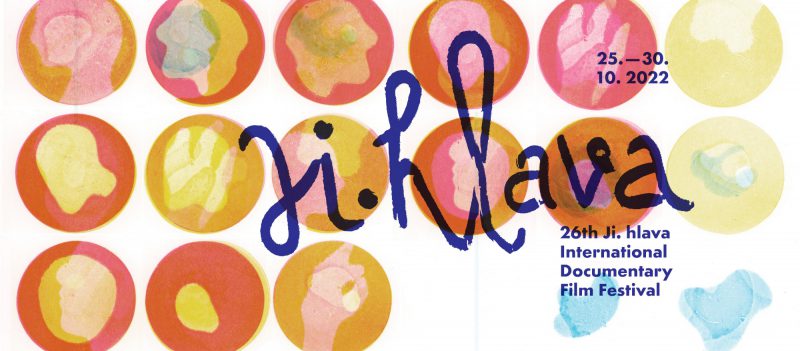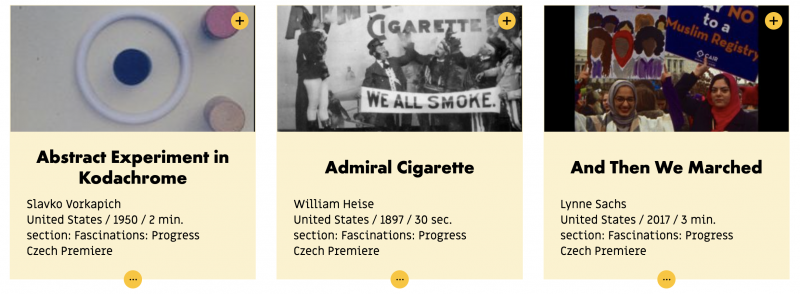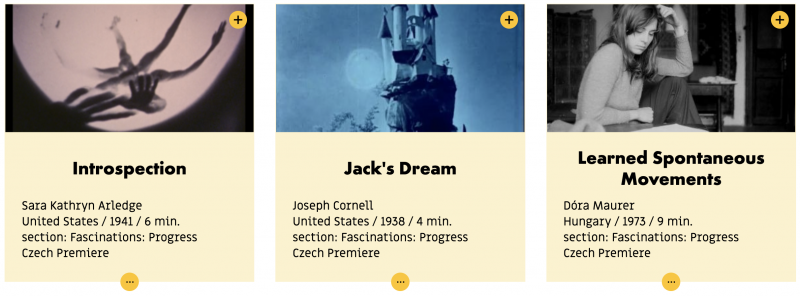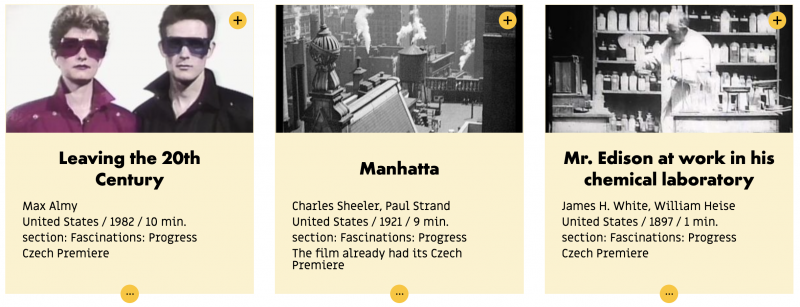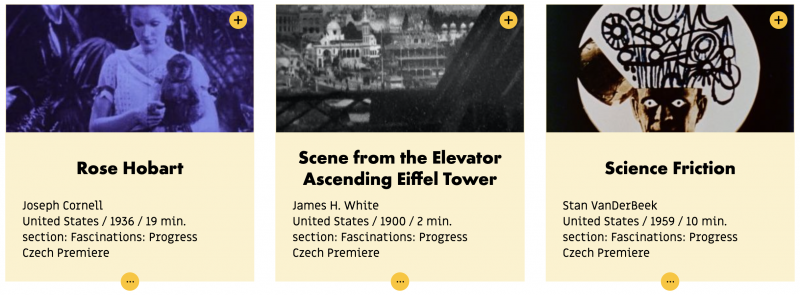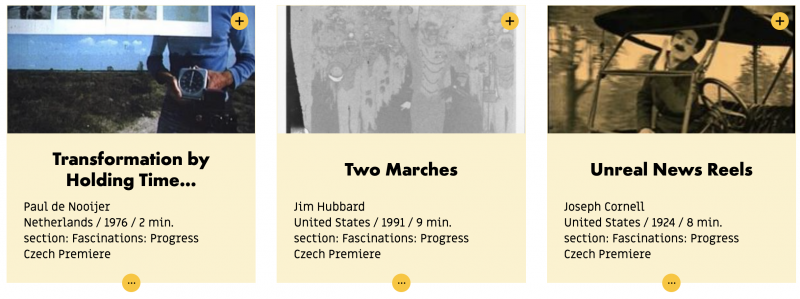Fascinations: Progress
26th Ji.hlava International Documentary Film Festival
Festival Dates: October 25-30, 2022
https://www.ji-hlava.com/programove-sekce/fascinace-pokrok
Film page: https://www.ji-hlava.com/filmy/a-potom-jsme-pochodovali
Fascinations: Progress
This year, in the ongoing series of retrospectives devoted to the history of avant-garde film through the ways of representation of certain topic or motive, we want to map the representation of “progress”. Something inscribed in the nature of the avant-garde itself, the topic was also widely represented – typically with enthusiasm and admiration, but sometimes also critically. We are interested in films from the beginning of cinema until today. The works from the beginning of cinema and between-the-war period. The “classical” works and “big” names, but also not so well-known films and authors.
Film Database
Abstract Experiment in Kodachrome
director: Slavko Vorkapich
original title: Abstract Experiment in Kodachrome
country: United States
year: 1950
running time: 2 min.
Admiral Cigarette
director: William Heise
original title: Admiral Cigarette
country: United States
year: 1897
running time: 30 sec.
And Then We Marched
director: Lynne Sachs
original title: And Then We Marched
country: United States
year: 2017
running time: 3 min.
synopsis
One day after the presidential inauguration in January 2017, the Womenʼs March took place in Washington D.C. Footage from the demonstration, shot with Super8 camera, is combined with archival footage of the protest marches from various moments in the US history. A visual whirl of the protesters᾽ faces and banners is accompanied by a childʼs voice which is trying to express as accurately as possible what it means to fight for oneʼs own rights.
biography
Lynne Sachs (* 1961) is an experimental filmmaker and poet, a director of more than 40 films and the author of many installations, performances and web projects. In her work she explores the relationship between the close and the remote, the intimate and the public, the visual and the audio.
Beginning a Skyscraper
director: Robert K. Bonine
original title: Beginning a Skyscraper
country: United States
year: 1902
running time: 40 sec.
Case Sound Tests
director: Theodore Case
original title: Case Sound Tests
country: United States
year: 1925
running time: 10 min.
Early Superimpositions
director: Frederick S. Armitage
original title: Early Superimpositions
country: United States
year: 1900
running time: 1 min.
Energy Energy
director: Karel Doing
original title: Energy Energy
country: Netherlands
year: 1999
running time: 7 min.
Europa
director: Stefan Themerson, Franciszka Themerson
original title: Europa
country: Poland
year: 1931
running time: 11 min.
Futuro
director: Mika Taanila
original title: Futuro – Tulevaisuuden olotila
country: Finland
year: 1998
running time: 28 min.
synopsis
A plastic puzzle of 16 parts, made in Finland: UFO, uterus, butterfly, playhouse. This prefabricated building, to be placed on the top of the mountains or the African coast, represented the dreamy future the humankind was about to enter in 1968. The story of the rise and fall of Futuro is the story of the idea of a future man, the idea which emerges and disperses.
biography
Mika Taanila (* 1965) is a Finnish experimental filmmaker and visual artist. In his films and video installations he often explores the history and the present of the utopian visions. His work has been screened at the major festivals and displayed in the galleries of contemporary art.
Glass
director: Bert Haanstra
original title: Glas
country: Netherlands
year: 1958
running time: 10 min.
Interim
director: Stan Brakhage
original title: Interim
country: United States
year: 1952
running time: 25 min.
synopsis
Stan Brakhage’s debut film tells the story of the surge, pacification, and outflow of desire awakened by an accidental encounter between two beings temporarily frozen in time — a man and a woman — who stand below an arcade of viaducts as one car after another speeds by above them. The sensual piano accompaniment was complemented by Brakhage’s roommate and future composer, James Tenney.
biography
Stan Brakhage (1933–2003) was a prominent, American experimental filmmaker, educator, and author of several books. Throughout his prolific filmography, you’ll find strong intimate films, exhilarating social documentaries, and purely abstract cinematic works; four-minute and four-hour works; and films shot with or without a camera.
Interior NY Subway, 14th Steet to 42nd
director: Gottfried Wilhelm Bitzer
original title: Interior NY Subway, 14th Street to 42nd Street
country: United States
year: 1905
running time: 5 min.
synopsis
This groundbreaking film shot six months after the opening of the New York subway follows a train traveling from Union Square to Grand Central Station. The dark tunnel is illuminated not only by the train that’s transporting the cameraman, but also by the headlights of a car driving along the sideline. The lighting takes full advantage of the architecture of the tunnel, which is reinforced with white columns arranged closely together one-by-one.
biography
G. W. Bitzer (1872–1944) was an American cameraman known mainly for his work he did for D. W. Griffith. At the beginning of his professional career, he worked for the American Mutoscope and Biograph Company, the first-ever production company in the US devoted solely to filmmaking, for which he also shot a film of the newly opened New York subway.
Introspection
director: Sara Kathryn Arledge
original title: Introspection
country: United States
year: 1941
running time: 6 min.
synopsis
An abstract dance film presenting disembodied parts of dancers clad in tight clothing that move around freely in a blank space. With this film, Arledge helped create a new film genre – ciné-dance – in which the dancing body rids itself of its physical limitations and takes on a pure form.
biography
Sara Kathryn Arledge (1911–1998) was a prominent, American experimental filmmaker whose most important works were Introspection (1941–1947) and What Is a Man? (1958). She also spent time painting and creating hand-painted glass slides, which she then compiled into the “stable films” Tender Images (1978) and Interior Garden (1978).
Jack’s Dream
director: Joseph Cornell
original title: Jack’s Dream
country: United States
year: 1938
running time: 4 min.
synopsis
Jack, a puppet dog, has a lucid dream where he encounters not only his brave counterpart but also a dragon, a king, and a princess. The plotline of this small puppet drama alone is, perhaps, enough to label it a surrealist work; but on top of that, the film is interspersed with shots of a sinking schooner and galloping seahorses. The soundtrack to the film was provided by Larry Jordan.
biography
Joseph Cornell (1903–1972) was an American surrealist, self-taught artist, a creator of collages and boxes with found objects, and a film collector. From the 1930s, he also created film collages using found footage, and in collaboration with filmmakers such as Stan Brakhage, Rudy Burckhardt, and Larry Jordan, he also made his own films.
Learned Spontaneous Movements
director: Dóra Maurer
original title: Megtanult önkéntelen mozgások
country: Hungary
year: 1973
running time: 9 min.
Leaving the 20th Century
director: Max Almy
original title: Leaving the 20th Century
country: United States
year: 1982
running time: 10 min.
Manhatta
director: Charles Sheeler, Paul Strand
original title: Manhatta
country: United States
year: 1921
running time: 9 min.
synopsis
Regarded as one of the first avant-garde films made in the US, Sheeler and Strand’s Manhatta is a dialogue of poetry, photography, and New York City. In the poem Mannahatta, which appears in the title cards throughout the film, Walt Whitman invokes the “original name” of his city, the word “resounding, healthy, untamed, musical, self-sufficient.” The bearer of this name is represented by 65 shots emphasizing the contours of artificial, natural, and human layers that intersect within it.
biography
Charles Sheeler (1883–1965) studied painting and drawing but made his living as a photographer working for architects. His own artwork stems from urban and industrial photography. Paul Strand (1890–1976) made a name for himself as a photographer in New York, having been attracted to modern architecture, the play of light and shadow, and the faces of impoverished immigrants.
Mr. Edison at work in his chemical laboratory
director: William Heise, James H. White
original title: Mr. Edison at work in his chemical laboratory
country: United States
year: 1897
running time: 1 min.
Oil – A Symphony in Motion
director: M.G. MacPherson
original title: Oil – A Symphony in Motion
country: United States
year: 1933
running time: 7 min.
Palace of Electricity
director: James H. White
original title: Palace of Electricity
country: United States
year: 1900
running time: 1 min.
Rhythm in Light
director: Melville Webber, Ted Nemeth, Mary Ellen Bute
original title: Rhythm in Light
country: United States
year: 1934
running time: 5 min.
Rose Hobart
director: Joseph Cornell
original title: Rose Hobart
country: United States
year: 1936
running time: 19 min.
synopsis
Oscillating between homage and obsession, the film distills the gestures, expressions, and posture of Rose Hobart, the heroine of the exotic Hollywood drama East of Borneo (G. Melford, 1931). Cornell’s version of the film, reckless with the plot and other characters, slowed down, shrouded in violet blue, complete with Brazilian underscore and eclipse shots, frees Hobart from the encumbrances of cliché, stereotyping, and narrative gossip.
biography
Joseph Cornell (1903–1972) was an American surrealist, self-taught artist, creator of collages and found-object boxes, and film collector. From the 1930s onwards, he also created film collages using found footage and made his own films in collaboration with filmmakers such as Stan Brakhage, Rudy Burckhardt, and Larry Jordan.
Scene from the Elevator Ascending Eiffel Tower
director: James H. White
original title: Scene from the Elevator Ascending Eiffel Tower
country: United States
year: 1900
running time: 2 min.
Science Friction
director: Stan VanDerBeek
original title: Science Friction
country: United States
year: 1959
running time: 10 min.
synopsis
VanDerBeek describes his neo-Dadaist film collage, shot using the technique of phase animation, as “a social satire aimed at the rockets, scientists, and competitive mania of our time”. In his vision, science inevitably becomes an accomplice of power, a means of torture, manipulation, and control that ultimately threatens not just some, but the entire planet.
biography
Stan VanDerBeek (1927–1984) was an American multimedia artist, thinker, and inventor who began working with film in 1955. Science Friction was named the best experimental film at the 1962 Oberhausen Film Festival. In 1964 he built the Moviedrome, an audiovisual laboratory for multimedia experiments, in a former silo.
The Dickson Experimental Sound Film
director: William K. L. Dickson
original title: The Dickson Experimental Sound Film
country: United States
year: 1894
running time: 1 min.
The Light Penetrates the Dark
director: Otakar Vávra, František Pilát
original title: Světlo proniká tmou
country: Czechoslovakia
year: 1930
running time: 4 min.
The Maltese Cross Movement
director: A. Keewatin Dewdney
original title: The Maltese Cross Movement
country: Canada
year: 1967
running time: 6 min.
Transformation by Holding Time (Landscape)
director: Paul de Nooijer
original title: Transformation by Holding Time (Landscape)
country: Netherlands
year: 1976
running time: 2 min.
Two Marches
director: Jim Hubbard
original title: Two Marches
country: United States
year: 1991
running time: 9 min.
synopsis
The first March on Washington for Gay and Lesbian Rights took place in October 1979, and another eight years later. In a non-violent juxtaposition of footage from both marches, Hubbard allows us to reflect on subtle and distinct shifts in the modes of protest expression, atmosphere, and shared perspectives.
biography
Jim Hubbard (* 1951) is an experimental filmmaker who has made films and videos centered around protests organized by members of the LGBTQ and AIDS communities. He founded the MIX festival of gay and lesbian experimental film and video in New York. He’s building a collection of interviews with people infected with AIDS.
Unreal News Reels
director: Joseph Cornell
original title: Unreal News Reels
country: United States
year: 1924
running time: 8 min.
synopsis
Joseph Cornell’s original compilation from his own film collection is based on the low-budget slapstick cartoons produced in the 1920s and 1930s by the Weiss Brothers, which Cornell turns into a parody of newsreels through subtle textual intervention.
biography
Joseph Cornell (1903–1972) was an American surrealist, self-taught artist, creator of collages and found-object boxes, and film collector. From the 1930s onwards, he also created film collages using found footage and made his own films in collaboration with filmmakers such as Stan Brakhage, Rudy Burckhardt, and Larry Jordan.
Velocità
director: Pippo Oriani, Guido Martina, Tina Cordero
original title: Velocità
country: Italy
year: 1930
running time: 13 min.
synopsis
Although Marinetti wrote the Manifesto of Futurist Cinema, Velocità is seen by some as the only futuristic film in its own right. Beside a dense intertextual network and a mechanic dance of the screen titles and objects dancing to stop-motion beats, the movie features a unique showcase of air painting on film and a few swinging frames from the streets of Turin.
biography
Pippo Oriani (1909–1972) was an architect and painter who claimed allegiance to the second wave of futurism. Velocità is his only film. He cooperated on it with Tina Cordero and Guido Martina, the founders of the Futurista Film company and the authors of the 1931 manifesto The Avant-garde Integral: Marinetti and futurism in film.
Year 2000
director: Gianfranco Brebbia
original title: ANNO 2000
country: Italy
year: 1969
running time: 13 min.
And Then We Marched
https://www.ji-hlava.com/filmy/a-potom-jsme-pochodovali
director: Lynne Sachs
original title: And Then We Marched
country: United States
year: 2017
running time: 3 min.
synopsis
One day after the presidential inauguration in January 2017, the Womenʼs March took place in Washington D.C. Footage from the demonstration, shot with Super8 camera, is combined with archival footage of the protest marches from various moments in the US history. A visual whirl of the protesters᾽ faces and banners is accompanied by a childʼs voice which is trying to express as accurately as possible what it means to fight for oneʼs own rights.
biography
Lynne Sachs (* 1961) is an experimental filmmaker and poet, a director of more than 40 films and the author of many installations, performances and web projects. In her work she explores the relationship between the close and the remote, the intimate and the public, the visual and the audio.

